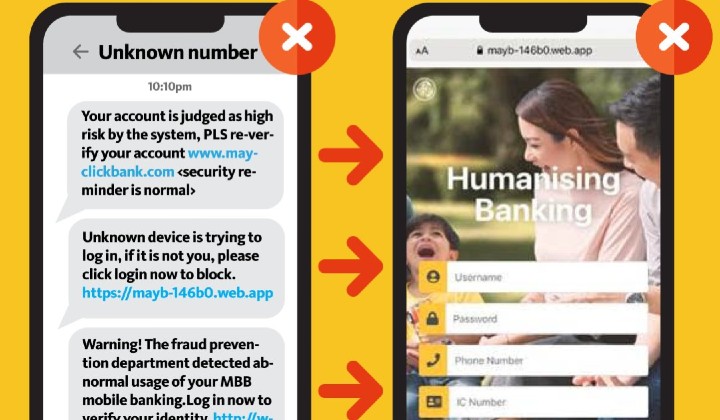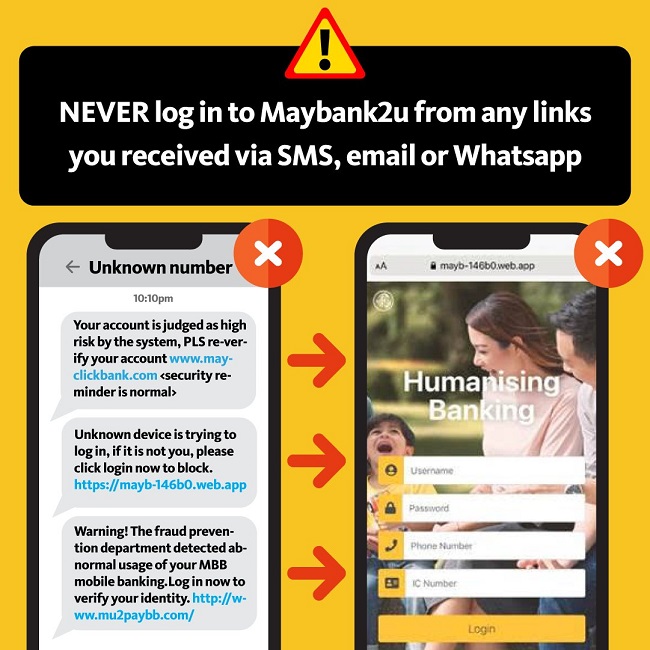Beware! There’s A New Fake Maybank Website Tricking Malaysians & Stealing Banking Information
Maybank alerts that these scams send messages that scare customers into clicking a bad link.

Subscribe to our Telegram channel for the latest stories and updates.
Scam alert! Maybank has just warned that there’s a new fake Maybank2u website targeting customers in order to steal their private banking information.
In a Twitter post, Maybank explained that the scammers lure unsuspecting customers into a fake Maybank2u website by sending links via SMS, WhatsApp or email.
#ScamAlert: We’ve received reports on a new fake Maybank2u website created by fraudsters to steal customers' banking details, which include your M2U username and password!
— Maybank (@MyMaybank) April 13, 2021
(01/03) pic.twitter.com/Qt88nUvokA
These messages are designed to scare customers into clicking the link by claiming that their bank accounts are judged as “high risk” by the bank’s system or that there’s an unknown attempt to log in, so customers must “re-verify” their details.
The resemblance between the fake website and the real thing is often uncanny, with both having near identical layouts and fonts.Customers are then swindled into revealing their login details, phone number and IC number.

What do you do if you’ve fallen victim to the scam?
Maybank states that the company will never send reminders via SMS, email or WhatsApp with links urging users to login or update their Maybank2u account.
Maybank urges customers who have accidentally revealed their Maybank2u login details on scam websites, to contact the bank immediately at 03-5891-4744.
(03/03)
— Maybank (@MyMaybank) April 13, 2021
If you have accidentally revealed your Maybank2u login details on scam websites, please contact us immediately at 03-5891-4744. Info https://t.co/e4BY3isfIL
How to protect yourself from phishing scams
A phishing website, or a “spoofed” site, is designed to steal your account password or other confidential information by tricking you into believing you’re on a legitimate website.

(Credit: Azizul Osman/Facebook)
Here’s some key information you should know about phishing scams and protecting your banking information.
Signs of a phishing scam:
- You received unidentified or suspicious SMS, email, phone calls asking for your personal information or your banking information.
- Scammers can also pretend to be from well-known organisations and request you to provide personal or banking information to ‘investigate’ on the matter they have called you about.
- The scam tactics can be different but the aim is the same – to obtain your personal or banking information so that they can steal from you.
How to protect yourself from phishing scam:
- DO NOT share your ATM card number, PIN number, username, password and Transaction Authorisation Code (TAC) number.
- DO NOT respond to requests to update 3rd party TAC mobile number.
- Take precautions when giving out any confidential information (including your credit card number) over the Internet/phone or any other channels.
- If you might have responded to an SMS, email or phone scam, contact your bank immediately.
Maybank also encourages their customers to key in the URL manually (http://maybank2u.com.my) whenever you need to access your account.
Share your thoughts with us on TRP’s Facebook, Twitter, and Instagram.
She puts the pun in Punjabi. With a background in healthcare, lifestyle writing and memes, this lady's articles walk a fine line between pun-dai and pun-ishing.





